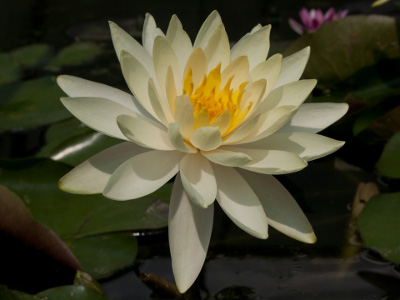Inner Light Water Lily
Category: Pond Plants

Facts about Inner light water lily plant. The Inner Light water lilies have a light yellow or white bloom with a warm yellow or cream center. The pale outer flowers are contrasted with the bright yellow inner leaves and stamen. The proper species name is Nymphaea 'Innerlight'.
The Inner light water lily grow in USDA zones four through eleven. They bloom earlier in the spring than other water lilies. The Inner light water lily is frost hardy but cannot survive a deep freeze.
The Inner light water lily have flowers up to six inches (15.2 cm) across. The leaves start off purple when they form until darkening to deep green. The leaves have a span of up to eight inches (20.3 cm) across. They have a spread of up to seven inches (17.8 cm). The flowers bloom just above the water’s surface. They have a marlilac rhizome. The Inner light water lily average two feet (61 cm) in depth from the tuber to the lily pad. The Inner Light needs at least eight inches (20.3 cm) of water depth.
The Inner light water lily can grow in partial or full sun. They can grow in containers at least 7.5 quarts (7 liter) or large ponds and they don’t grow in running water or streambeds. Because the Inner light water lily are not variegated, they need more sunlight than other lilies. Unlike the Mexican lily, they cannot lift up their leaves out of the water to survive crowding.
The Inner light water lily averages one to two blooms per half dozen lily pads. The lilies need to be planted five to seven feet (1.52 to 2.13 meters) apart.
The Inner light water lily were developed by Doctor Kirk Strawn of the United States and debuted in 1997. This species is non-invasive compared to the Mexican lily. It attracts bees and amphibians like frogs but not butterflies.
The Inner light water lily generates a lovely water surface cover. It is a nitrate removing plant. It can be planted in natural clay or silt as long as there is sufficient water cover. The Inner light water lily can also be grown in a patio water garden. It will not grow in a ditch, since there isn’t sufficient regular water covering the root.

 Back To Category Pond Plants
Back To Category Pond Plants